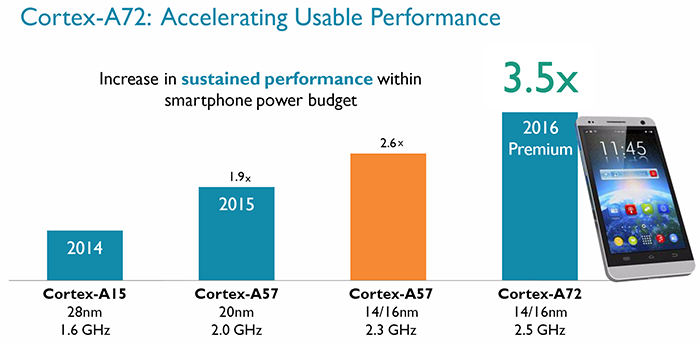ARM Technology Update
Advancements in processor technology occur at an uneven pace because they're dictated by two main factors: improved design and smaller manufacturing process. They are inextricably entwined to one another as a technology company's roadmap needs to take both into account when designing processors in the future.
A case in point is ARM. The British company designs the processors that power the vast majority of smartphones and tablets as well as the technology behind billions of controller chips that remain hidden from public view. Mating the technology with the appropriate manufacturing process is key for ensuring that leading-edge products have the silicon horsepower demanded by users.
As an example, ARM announced the Cortex-A72 processor in February 2015. Along with other intellectual property (IP) necessary for building an entire chip that powers premium smartphones and tablets, the Cortex-A72 will become the beating heart of many premium devices this year.
Companies such as ARM cannot design ever-bigger processors because, in a mobile environment, partners who manufacture handsets and tablets need to make sure costs are kept in check and long-standing thermal limits are not breached. This is where the benefits of advanced manufacturing processes come in; moving to a smaller geometry - say, 28nm to 16nm - paves the way for smaller-sized processors and lower power consumption.
Multiple opportunities at one time
Yet building an architecture such as the Cortex-A72 for the latest manufacturing process is a balancing act between size, power, cost, yield and time. Complicated, eh?
The underlying strength of the Cortex-A72 processor and associated silicon that constitutes a full system-on-chip (SoC) is best realised by the very latest manufacturing process. This is true of any leading-edge design, which works best when pushing the manufacturing envelope, because absolute performance is key. You know when Samsung or Qualcomm announce a new processor with 40 per cent better performance than the previous generation? That's usually indicative of clever design engineering and a move to a newer manufacturing process.
Such talk of mating design and manufacturing process is particularly relevant today as a number of high-profile devices will ship soon with the best of both worlds: advanced architecture and 16/14nm process production. This year's flagship products based on the ubiquitous ARM architecture will be manifestly better than yesterday's.
16nm production for cutting-edge SoCs
It is highly likely that handset- and tablet-makers will choose either TSMC or Samsung's latest processes for production of the SoCs in their devices. TSMC has already proved that it can deliver 16nm FinFET technology which will help the ARM Cortex-A72 architecture to be delivered in its fullest, most powerful form. Samsung, too, is delivering its 14nm process in volume in the second half of 2016.
As an illustration, TSMC's 16nm FinFET Plus technology - where more transistors are placed in a given die area - provides over 40 per cent extra speed at the same power consumption or over 60 per cent less energy at the same performance when compared to the architecture built on 28nm technology broadly in use on premium smartphones and tablets today. That's a massive improvement which propels the Cortex-A72, for example, to offering staggering performance numbers.

A combination of enhanced technology available on the Cortex-A72 and move to a 14/16nm process offers a fantastic 3.5x improvement over the best SoC technology and manufacturing process of 2014. Think about that for a second. Performance is improved by a substantial degree without increasing the overall power consumption of your smartphone or tablet.
ARM works very closely with Samsung, TSMC and the other foundry companies - the guys who build the chips - to guarantee that its processor technology operates seamlessly with new, advanced manufacturing processes. The ARM engineering and physical IP teams collaborate closely to validate the technology such that any new design is available to the eager market as quickly as possible.
Various processors are supported by this collaborative core-hardening approach known as POP IP, which is available to ARM's customers as a means of accelerating the time it takes to understand and implement a new technology and thus turning a virtual product into fully-functioning silicon in the fastest possible time-frame. Time is money after all.
It is more than just silicon
The story behind new processors is often obscured from the public because, for most, it is the end product that is of most relevance. That isn't to say innovation and collaboration become stifled; far from it. ARM is working with all of the major foundry companies with the express aim of producing the best designs for companies who need that very last ounce of performance.
The application-processor landscape is more than just designing a competitive CPU. The close relationship ARM enjoys with the foundry companies is crucial in guaranteeing that thousands of man-hours spent designing and fine-tuning an architecture is fully realised by a physical processor that teases the best out of the latest manufacturing processes.
Well-known companies such as HiSilicon, MediaTek, Rockchip and Freescale have already confirmed that their next-generation processors will feature the Cortex-A72 processor built on 16nm technology. More performance from a new architecture is combined with more performance from a smaller manufacturing process. That's a win-win situation for the consumer looking for a high-quality experience with their next mobile device. Think innovation, think ARM.







